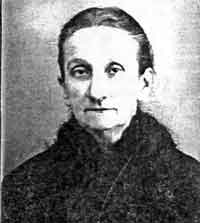|

Kathleen Boyle (1869-1941)
(Maud Cox collection)
|
Boyle [née
Jones], Kathleen
[Catalina] (1869-1941), headmistress and
educationist, was born on 18 October 1869 at 54 Rathgar
Road, Dublin, the daughter of Francis P. Jones, a civil engineer
who worked in the General Valuation office, and Elizabeth
Dowling, both with Church of Ireland background.
Kathleen was
sent to England to study literature in the university of
Cambridge. Her father died in 1886 and the family emigrated to
Rio de Janeiro, where she taught English, music and arts in the
Colegio Americano Brasileiro. A yellow fever outbreak forced
them to travel to Argentina. Their cousins John and Robert
Hallahan, sons of the Rev. John Hallahan of Castletown,
Berehaven (Co. Cork), were physicians in the British Hospital of
Buenos Aires, and in 1891 received Kathleen’s mother and her
four children.
In Buenos
Aires Kathleen resumed her teaching profession. In 1894 she
founded the Colegio Inglés of San Martín, which was renamed
later "San Patricio." Different to other Irish schools, from the
beginning Colegio San Patricio was open to students of any
origin or religion. Kathleen married to Andrew T.S. Boyle in
1899. Boyle was a former major in the British army and an
engineer, and founder of the boy scouts group of San Martín.
Andrew Boyle was born in 1844, went to school in England, and
entered the military school at Sand Hutton. In 1888, serving in
the Connaught Rangers 88th Regiment (the Devil's Own), he was
promoted to Major. During his appointment in India, Boyle
received eight wounds that he would carry during the rest of his
life. He converted to Catholicism after a cholera break in
India. He was shocked when all the ministers left with their
families and the Catholic priests remained. Andrew Boyle retired
from the army and was hired by a British company with businesses
in Argentina. He worked in several Argentine cities and his last
executive position was in the Ferrocarril Buenos Aires al
Pacífico. Kathleen and Andrew married in St. John's
Pro-Cathedral, the Anglican church of Buenos Aires. She later
converted to Catholicism and they both remarried and re-baptized
their children in the new faith.
From the
beginning, Colegio San Patricio was a laboratory to test the
latest educational techniques. Kathleen implemented new methods
to teach English as a foreign language and, according to the
examination results, there was a significant improvement of the
students’ knowledge and enthusiasm. Her motivation schemes,
including awards to the best students, prompted the children to
work harder. When the number of students grew and she was not
able to teach personally to all of them, she hired qualified
teachers graduated from prestigious Argentine schools.
Kathleen's
work was not limited to education. On Sundays the major of San
Martín frequently received her request to visit the local prison
in order to take cigarettes and magazines to the convicts. Her
three daughters, Catalina, Agatha and Ruth, wandered with
Kathleen through the poorest areas distributing supplies to
destitute families. One day, when Kathleen was told that a
Chinese immigrant had died from an infectious disease and in
appalling circumstances, she was the only one with the courage
to get into the room, wash the corpse, and prepare it for
burial. These examples chosen among several cited by newspapers
in Kathleen's obituary are an expression of her qualities.
At Kathleen
Boyle's time, Argentina was a country whose population was
growing dramatically. Its post-colonial bourgeois structure was
challenged by massive inflows of new immigrants from disparate
cultures in Europe and the Middle East. On 4 August 1932 the
Standard paper edited by Michael G. Mulhall, published a
letter sent by Katheen Boyle (signing as Miss Justice). She
argued against the perspective of some readers who thought that
women should give up their jobs in favor of men in order to
relieve unemployment. In her letter Kathleen re-focused a gender
issue on its actual social context. A proposed ten per cent cut
on salaries, she said, should be applied only to those with
higher income, not to low-paid workers with large families. She
ended with an appeal to wealthy men to sacrifice half of their
salaries and see that those working under them earn a living
salary.
Kathleen
Boyle died on 27 October 1941. A street in San Martín's district
Villa Piaggio was named after her, and a bronze bust was placed
in Nueve de Julio and Mitre streets, and later moved to the
cemetery (though people thought it was Evita and would either
shower flowers or throw rocks at it!). Her life challenges the
traditional historical narrative of the Irish in Argentina,
which frequently depicts Roman Catholic male emigrants from
rural townlands in the Irish midlands or Wexford who settled in
the countryside of Buenos Aires or other provinces to work in
sheep-farming.
Edmundo
Murray
References
- Coghlan,
Eduardo A. Los Irlandeses en la Argentina: Su Actuación y
Descendencia. Buenos Aires, 1987.
- Murray,
Edmundo. Catalina Street in Ciudad de San Martín, Buenos
Aires. Web site "Irish Migration Studies in Latin America"
http://www.irishargentine.org, cited December 26, 2004.
- Roger,
María José. The Children of the Diaspora: Irish Schools and
Educators in Argentina, 1850-1950. Web site "Irish Migration
Studies in Latin America" http://www.irishargentine.org, cited
March 12, 2004.
|


